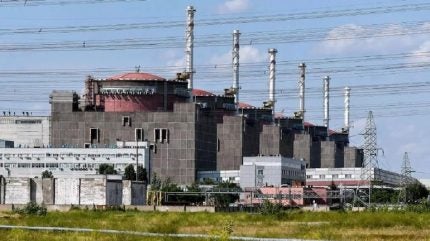
Repairs are expected to begin this week to restore off-site power links to the Zaporizhzhia nuclear power plant (ZNPP), more than three weeks after the site lost its connection to the grid for the tenth time during the Russia-Ukraine military conflict.
“Immediately after the plant last month lost all off-site power, the International Atomic Energy Agency (IAEA) has been engaging closely with both sides to help create the necessary security conditions on the ground so that their technicians can carry out repair work that is of crucial importance for nuclear safety and security,” IAEA Director General Rafael Mariano Grossi said.

Discover B2B Marketing That Performs
Combine business intelligence and editorial excellence to reach engaged professionals across 36 leading media platforms.
“This region is an active war zone, and we must be very careful in how we approach this complex and sensitive matter. Repairs to the power lines are needed on both sides of the frontline, at locations several kilometres from the site itself,” he continued. “In line with the IAEA’s technical and impartial mission, I’m continuing to consult with the Russian Federation and Ukraine to enable this work to proceed within the next few days. They both tell me that they also want the repairs to go ahead. The current situation – with the plant relying on emergency diesel generators for weeks now – is not sustainable.”
Before the conflict, the ZNPP had access to 10 power lines. In recent years, that was reduced to two. However, the 330 kV Ferrosplavnaya-1 line was lost on 7 May and the sole remaining 750 kV Dneprovskaya line was disconnected on 23 September.
Seven emergency diesel generators (EDGs) are currently producing electricity for the site, mainly for the water pumps to cool the fuel in its six shutdown reactors as well as it’s the stored used fuel. Another 13 EDGs are in standby mode, with the plant continuing to alternate the ones in use in order to carry out necessary servicing. ZNPP’s safety systems continue to be in operation for all reactor units and used fuel pools, to maintain nuclear safety.
The IAEA team at the plant continued to report that there has been no increase in the temperatures within the coolant in the reactors or the used fuel pools, indicating that the nuclear fuel continues to be cooled effectively and that nuclear safety is currently maintained.

US Tariffs are shifting - will you react or anticipate?
Don’t let policy changes catch you off guard. Stay proactive with real-time data and expert analysis.
By GlobalDataThe team earlier conducted a walkdown of the site and observed the EDGs in operation as well as all essential service sprinkler ponds, which provide cooling for the reactors and used fuel pools, noting that all were full and operating. The team also performed radiation monitoring, confirming that radiation levels were normal for the site.
IAEA team members also met with the ZNPP’s Emergency Preparedness and Response (EPR) Department. They were informed that the site’s EPR plan was approved and became effective from last month. The team was also informed that the ZNPP had established a new off-site emergency centre in the nearby town of Energodar, as the former off-site centre is inaccessible due to its location on the other side of the frontline. This facility serves as a backup to the temporary on-site emergency centre – the original on-site centre remains unavailable – and receives the same plant data, ensuring continuity in emergency coordination if needed.
The team visited the six pumping stations located at the ZNPP channel that was recently isolated from the cooling pond and that supplies water for the cooling of several plant systems. The team assessed equipment status and operability. The visit confirmed that key pumps supporting service water, fire protection, and the common EDG cooling were functioning as needed. The height of the water in the channel remains about two metres above the minimum level for the pumps to operate.
Mikhail Ulyanov, Permanent Representative of the Russian Federation to International Organisations in Vienna told RIA Novosti on 14 October: “Active preparations are currently underway. We expect repair work on both power lines to begin before the end of this week.” However, he added: “In order for this to become a reality, it is necessary to agree on a local ceasefire in the areas where repairs will be carried out.”
Earlier, Associated Press cited “diplomats” as saying that the IAEA was pushing Russia and Ukraine to conclude a local ceasefire to enable repairs to the external power supply. According to one of these sources, the IAEA proposes to restore the supply in two stages. During the first stage, a cease-fire will be established within a radius of 1.5 km for the repair of the Dneprovskaya power line. During the second stage, a second ceasefire zone will be created to allow repair the Ferrosplavnaya-1 line.
Restoring the external power supply to ZNPP remains a key task, despite the successful operation of backup power sources, ZNPP Communications Director Evgeniya Yashina, told TASS. “Although we have backup power, it is important to restore the plant’s external power supply. We cannot comment on the timing for restoring the external power supply due to the complex and sensitive operational situation,” she said. She added that as soon as the situation allows, the station’s staff, along with specialists, are ready to promptly begin the necessary repair work. She repeated that the ZNPP continues to consistently meets its energy needs thanks to its backup diesel generators.
Russia took control of the six-unit ZNPP in March 2022 and on 5 October 2022, Russian President Vladimir Putin signed a decree formally transferring ZNPP to Russian jurisdiction.





